Introduction
This article will help you better understand mosaic by introducing the development history, definition, raw materials, major techniques and modern applications of mosaic art. You will be able to make better decisions on selecting mosaic materials and patterns for home decoration.
What is mosaic?
Mosaic refers to patterns or shapes collaged and inlayed by colorful blocks made of glass, stone, shell, tile etc. Mosaic can decorate walls or other interfaces with diverse patterns, which make up for drawbacks of paintings, such as limited durability and visual effect. In fact, mosaic is a perfect combination of durability and visual effects.
According to raw materials, mosaic can be basically divided into glass, porcelain, stone, metal, and shell. Glass mosaic is clear, colorful, and sparkling, which can create abundant three-dimensional visual effect in different lighting conditions (Figure 1). Besides, tile mosaic has a variety of shapes and sizes with hard texture (Figure 2). Moreover, stone mosaic is made of natural stones, which can create a rustic style with a strong decorative effect (Figure 3).

Figure 1. Porcelain Mosaic

Figure 2. Tile mosaic


Figure 3. Stone mosaic
Mosaic techniques
Mosaic art usually applies inlay techniques to arrange and attach corrosion resistant materials into decorative patterns or paintings. When you change your view or position, you will discover a twinkling and flickering effect on the mosaic (Figure 4). With multiple choices of shape, it is easy to model mosaic patterns. No matter geometric shapes, figures, plants, or animals, mosaic can always bring us aesthetic enjoyment through fluctuations on two-dimensional carriers (Figure 5).

Figure 4. Mosaic blocks

Figure 5. Mosaic artworks
Development history of mosaic art
Mosaic as an ancient art form originated from Mesopotamia Plain since approximately 2,500 BC, but it achieved pervasive development in the Italian Peninsula. After Christianity gained the legal status, a large number of churches were built across Europe and most of them were decorated with religious paintings. With supreme visual effect and material durability, mosaic became the prior choice of church decorations.
In the 11st century, Christianity was divided into the Catholic Church and the Orthodox Eastern Church. During that period, Byzantine mosaic with religious icons (e.g. Jesus Christ, the Virgin Mary) achieved prosperity. Later, in the 17th century, mosaic craftsmanship emerged in Islamic nations. Meanwhile, stone mosaic paintings became popular in Italy, specially in Rome and Florence. Comparing to Byzantine mosaic, Italian mosaic is much more complex, since raw materials are cut into different shapes and sizes and final works need to be polished.
In ancient times, mosaic was once a mainstream decorative means for high-end demands. For example, Jame Mosque of Yazd was built in Iran in the 12th century. The dome, tower, and interior space of the mosque are all covered by exquisite blue and white mosaic and deliver a sense of loftiness and purity (Figure 6).

Figure 6. Jame Mosque of Yazd, Iran
In the 1200s, skilled Italian craftsmen were invited to decorate Westminster Abbey with luxuriant mosaic. The mosaic pavement of 24 square feet in Westminster Abbey is particularly impressive (Figure 7).

Figure 7. Westminster Abbey, London
In the early 20th century, Antony Gaudy, the talented Spanish architect used mosaic to visualize his unrestrained creativity. For instance, almost all walls and sculptures in Park Guell are decorated with colorful tile mosaic of irregular sizes and shapes, thus the entire park looks like a castle in the sweetest fairy tale (Figure 8). This architectural site has also been listed as a World Cultural Heritage by UNESCO.

Figure 8. Park Guell, Barcelona
Application of mosaic art in the modern context
Nowadays, the mosaic is used to decorate walls, furniture, as well as curved surface or corner no matter indoor or outdoor. Mosaic can always perform great flexibility and adaptability to cover any irregular surface smoothly and completely. Just like impressionist art, mosaic art does not focus on details excessively, but clear tones and patterns can be identified at a distance, and bring the audience extraordinary visual experience (Figure 9 & 10).

Figure 9. Starry Night, oil on canvas, by Vincent Van Gogh, 1889




Figure 10. Mosaic Starry Night in the bedroom
Mosaic has broad uses in modern indoor design. For example, it can be used to decorate the backsplash of the wash basin or bathroom wall, which is elegant and waterproof (Figure 11&12).


Figure 11 & 12. Mosaic applied in indoor design
Conclusion
During the development process, mosaic art was always connected to religion. In the 21st century, mosaic has been revitalized and applied in modern decorative design widely. Mosaic always has rich and unique artistic expressive power. Raw materials and techniques of mosaic can achieve expected decorative effect on most objects. Mosaic can flexibly apply themes in size and shape and enrich image to satisfy consumer demand. All in all, mosaic is recognized as an ancient art form with a brand new life.













Post comments
Leave A Reply
Your email address will not be published.